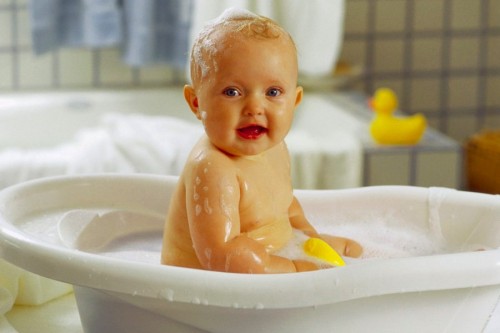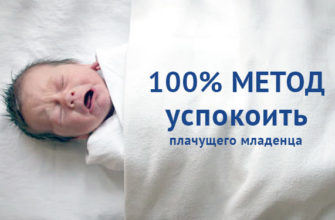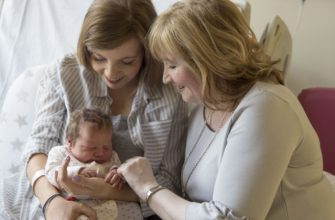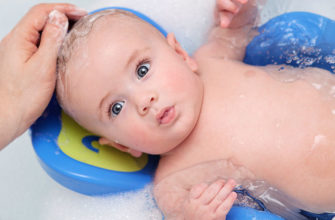- The procedure for bathing the baby should be daily. “Why,” you ask, “because there is nowhere for the crumb, who is always in the crib, to get dirty?” And then, when bathing a baby, parents not only care about the cleanliness of his body, but also create a certain physical load for him, which makes it possible to relax and relieve tension from muscles that are in constant tone.
 Parents should remember: taking a daily bath is a completely everyday routine, in which only the baby himself and the one who bathes him should participate. Inexperienced parents often wonder if which bath is more suitable for this. An excellent option is a bath with a cork that allows you to drain the water after the procedure. For bathing the baby in the first weeks of life, you can use all kinds of devices (mattresses, "slides"), making the procedure safer. Supporting the baby, they facilitate the task and relieve the mother of unnecessary anxiety. Bathing grown up baby (starting from a month old) can be carried out already in a large bath. The baby quickly grows out of the baby bath: it limits the freedom of its active movements. Do you also know the picture when a five-kilogram child, hunched over, floundering in a cramped plastic dish? It is difficult to expect any benefit from such bathing. Immediately transfer the robust fellow to a spacious bathtub.
Parents should remember: taking a daily bath is a completely everyday routine, in which only the baby himself and the one who bathes him should participate. Inexperienced parents often wonder if which bath is more suitable for this. An excellent option is a bath with a cork that allows you to drain the water after the procedure. For bathing the baby in the first weeks of life, you can use all kinds of devices (mattresses, "slides"), making the procedure safer. Supporting the baby, they facilitate the task and relieve the mother of unnecessary anxiety. Bathing grown up baby (starting from a month old) can be carried out already in a large bath. The baby quickly grows out of the baby bath: it limits the freedom of its active movements. Do you also know the picture when a five-kilogram child, hunched over, floundering in a cramped plastic dish? It is difficult to expect any benefit from such bathing. Immediately transfer the robust fellow to a spacious bathtub.- The temperature of the water in the bath should not exceed 36 degrees. Lower water temperatures are sometimes even welcome. Punctual parents, to make sure that they bathe the baby in the water of the right temperature, can use different types of thermometers (for example, alcohol or electric). All others can take advantage of the old way by lowering the elbow into the water: the absence of any sensations at the same time indicates that the water temperature is equal to body temperature. In the process of bathing, you do not need to add hot water to the bath: cooling the water in a natural way will help harden the baby.
- It is undesirable for the air temperature in the bathroom to exceed normal room temperature (~ 22 degrees). During bathing, it is advisable not to close the door to the bathroom. Fears associated with the fear of catching a baby in this way are completely unfounded: it is much more dangerous to bring him from a steamed room into a room with a lower temperature. Equally destructive for a baby is a constant stay in a room too hot (above 25 degrees): in this case, colds will become his constant companions in the future. To disorder the natural thermoregulation of the infant body, it is enough to overheat it several times. Restoring normal heat transfer will be much more difficult.
- For bathing crumbs, ordinary tap water is quite suitable, no boiling is required for this. You should not dramatize the situation if the baby accidentally takes a drink of water directly from the bath: some kids even like it. There will be no harm from this (We also read: in which water to bathe a newborn child, boil water, add potassium permanganate?).
- Is water in your ear dangerous? During bathing, this happens quite often; This also does not constitute a particular danger, so you should not cover the ears of the crumbs with lumps of cotton wool. But to dry them after bathing with the help of cotton turundochki does not hurt.
- Is it permissible to swim in the bath together with the baby? It is noticed that even very shy and moody children are happy to bathe in the same bathtub with their beloved mom. Occasionally, one can afford such procedures (of course, if the mother does not have any infectious diseases), including active games using special educational toys (bath toys), however, it is not worth introducing such bathing into everyday practice. We read in detail:Is it possible to bathe in the same bathtub with a newborn? The opinion of doctors and mothers
- During bathing, the baby should actively move. The tiniest (up to three months) babies just need to be given the opportunity to swim in a large bathtub on the tummy (with mom's support for the chin and tummy) or on the back (it is necessary to support the head of the baby). Any activity of the child, manifested in a cheerful swing of arms and legs, should be encouraged in every way (read also: infants swimming) This not only helps to relax his muscles, but also allows you to get rid of excess energy. Tired, the baby will quickly fall asleep in a healthy, sound sleep. If the baby is too sluggish during bathing, this most likely indicates that the baby is too hot.
- Fear of water most often develops in babies due to a negative bathing experience. The baby can be frightened by too bright lighting, loud noises, parental “hysteria” about the accidental immersion of a baby in water. Remembering that the bathing procedure should be pleasing to the child, parents must create all conditions for this, eliminating any factors that could cause him even the slightest discomfort. Do not arrange events from this everyday routine. At this moment, excited cries, vanity, minute-by-minute measurements of the temperature of the water in the bath and attempts to protect the baby from the nonexistent draft are completely unacceptable (what to do if the child is afraid to bathe in the bathroom).
- When bathing crumbs is not worth it: to liken a bathroom to a steam room, lay a diaper on the bottom of the bathtub, cover it with the bare shoulders of the baby not covered by water, pour a large amount of special bathing products (designed even for the most sensitive skin) into the water, leave the baby unattended even for one give me a sec.
READ ALSO: How to bathe newborns
GUIDE video
http://www.youtube.com/watch?v=7DUlXD8le4U
***
***
http://www.youtube.com/watch?v=C7WTk34ksLY
http://www.youtube.com/watch?v=Wbz2vhogcUs








